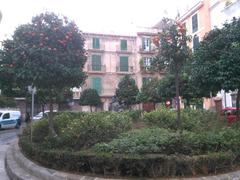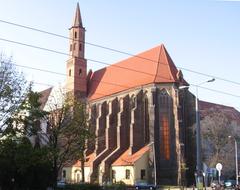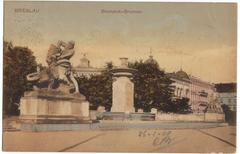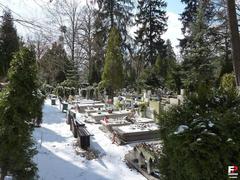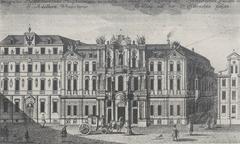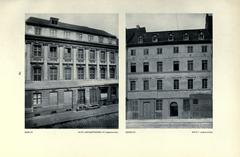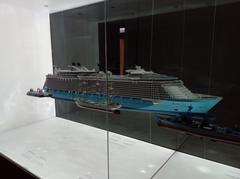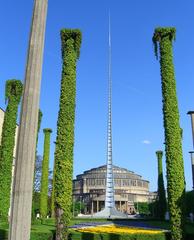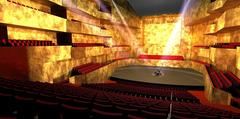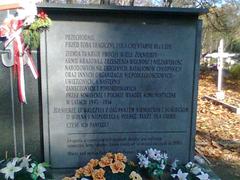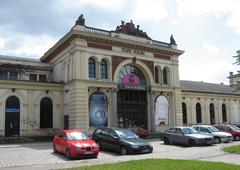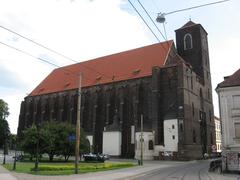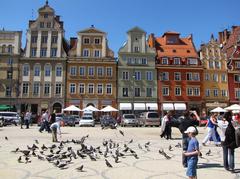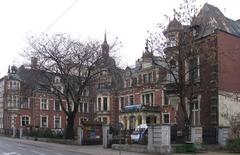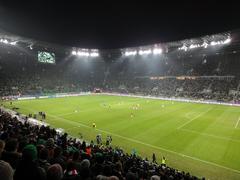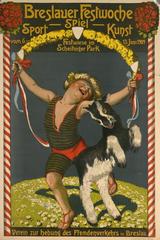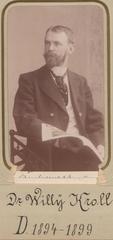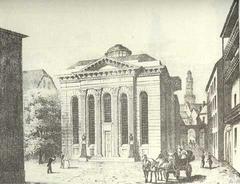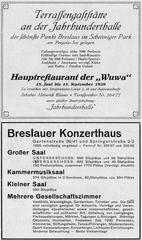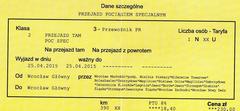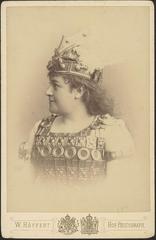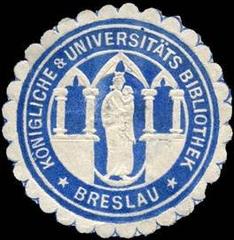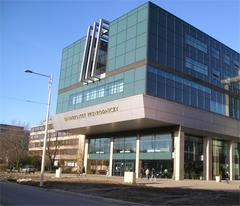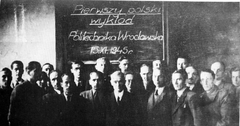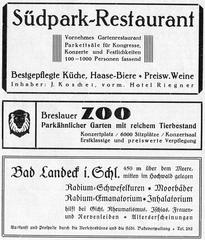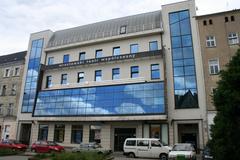
Visiting Zwierzyniecka Footbridge in Wrocław: History, Tickets, and Tips
Date: 17/08/2024
Introduction
Nestled in the heart of Wrocław, Poland, the Zwierzyniecka Footbridge stands as a remarkable blend of modern design, cultural significance, and environmental sustainability. Spanning the picturesque Oder River, this bridge is more than just a functional crossing; it serves as a vital link between the lush Szczytnicki Park and the renowned Wrocław Zoo, facilitating pedestrian and cyclist movement while offering breathtaking views and aesthetic pleasure. Designed by the esteemed architectural firm Ponting Bridges, the footbridge was completed in 2013 and has since become an iconic landmark in Wrocław.
Its sleek, minimalist design, characterized by clean lines and the use of modern materials like steel and concrete, speaks volumes about the city’s commitment to sustainable urban development. Visitors are drawn not only to its structural elegance but also to its cultural and environmental considerations, making it a must-visit attraction for both locals and tourists alike. Whether you’re an architecture enthusiast, a nature lover, or simply looking for a scenic spot to enjoy a leisurely stroll, the Zwierzyniecka Footbridge offers something for everyone. (Wroclaw Guide, Wikimedia Commons)
Table of Contents
- the-zwierzyniecka-footbridge-in-wrocław-design-history-and-visitor-tips)
- [Design and Construction](#design-and-constructiondesign-and-construction)
- [Structural Features](#structural-featuresstructural-features)
- [Aesthetic Elements](#aesthetic-elementsaesthetic-elements)
- [Environmental Considerations](#environmental-considerationsenvironmental-considerations)
- [Cultural Significance](#cultural-significancecultural-significance)
- [Visitor Information](#visitor-informationvisitor-information)
- [Travel Tips](#travel-tipstravel-tips)
- [Nearby Attractions](#nearby-attractionsnearby-attractions)
- [Special Events](#special-eventsspecial-events)
- [Photographic Spots](#photographic-spotsphotographic-spots)
- [Accessibility](#accessibilityaccessibility)
- [FAQ](#faqfaq)
- guide-to-zwierzyniecka-footbridge-visiting-hours-tickets-and-top-tips)
- [Introduction](#introductionintroduction)
- [Getting There](#getting-theregetting-there)
- [Best Time to Visit](#best-time-to-visitbest-time-to-visit)
- [What to Bring](#what-to-bringwhat-to-bring)
- [Nearby Attractions](#nearby-attractionsnearby-attractions)
- [Historical and Cultural Significance](#historical-and-cultural-significancehistorical-and-cultural-significance)
- [Dining Options](#dining-optionsdining-options)
- [Safety Tips](#safety-tipssafety-tips)
- [Accessibility](#accessibilityaccessibility)
- [Photography Tips](#photography-tipsphotography-tips)
- [Local Customs and Etiquette](#local-customs-and-etiquettelocal-customs-and-etiquette)
- [FAQ](#faqfaq)
- [Additional Resources](#additional-resourcesadditional-resources)
- [Conclusion](#conclusionconclusion)
Exploring the Zwierzyniecka Footbridge in Wrocław: Design, History, and Visitor Tips
Design and Construction
The Zwierzyniecka Footbridge, located in Wrocław, Poland, is a notable example of modern pedestrian bridge design. This footbridge spans the Oder River, connecting the areas of Szczytnicki Park and the Wrocław Zoo. The bridge’s design is a blend of functionality and aesthetic appeal, making it a significant architectural landmark in the city.
The footbridge was designed by the renowned architectural firm, Ponting Bridges, known for their innovative and sustainable bridge designs. The construction of the Zwierzyniecka Footbridge was completed in 2013, and it has since become a vital pedestrian link in Wrocław. The bridge’s design incorporates a sleek, minimalist aesthetic, characterized by its clean lines and use of modern materials such as steel and concrete.
Structural Features
One of the most striking features of the Zwierzyniecka Footbridge is its suspension design. The bridge is supported by two main pylons, which are anchored into the riverbanks. These pylons support the main cables, which in turn hold up the bridge deck. This suspension design not only provides the necessary structural support but also adds to the visual appeal of the bridge.
The bridge deck is made of reinforced concrete, providing a sturdy and durable surface for pedestrians. The deck is also designed to be wide enough to accommodate both pedestrians and cyclists, promoting sustainable modes of transportation. Additionally, the bridge is equipped with LED lighting, which enhances its visibility and safety during nighttime.
Aesthetic Elements
The Zwierzyniecka Footbridge is not just a functional structure; it is also a work of art. The bridge’s design incorporates several aesthetic elements that make it a visually appealing landmark. The pylons and cables create a dynamic and elegant silhouette against the skyline, while the use of modern materials gives the bridge a contemporary look.
The bridge’s lighting system is another key aesthetic feature. The LED lights are strategically placed along the bridge deck and pylons, creating a stunning visual effect at night. The lights can also be programmed to change colors, adding to the bridge’s visual appeal and making it a popular spot for evening strolls and photography.
Environmental Considerations
In addition to its architectural and aesthetic features, the Zwierzyniecka Footbridge also incorporates several environmental considerations. The bridge’s design minimizes its impact on the surrounding environment, particularly the Oder River and its ecosystem. The use of sustainable materials and construction methods further enhances the bridge’s environmental credentials.
The bridge also promotes sustainable transportation by providing a safe and convenient route for pedestrians and cyclists. This helps to reduce the reliance on motor vehicles, thereby contributing to the reduction of carbon emissions in the city. The bridge’s design also includes features such as rainwater drainage systems, which help to manage stormwater runoff and protect the river’s water quality.
Cultural Significance
The Zwierzyniecka Footbridge holds significant cultural value for the city of Wrocław. It serves as a vital link between two important cultural and recreational areas: Szczytnicki Park and the Wrocław Zoo. The bridge provides easy access for visitors to these attractions, enhancing their overall experience.
The bridge is also a popular spot for local residents and tourists alike. Its scenic location and stunning design make it a favorite destination for walks, photography, and leisure activities. The bridge has become an iconic symbol of Wrocław’s commitment to modern architecture and sustainable urban development.
Visitor Information
Visiting Hours: The Zwierzyniecka Footbridge is accessible to visitors 24 hours a day, seven days a week, making it a convenient destination for both early morning and late-night strolls.
Ticket Information: There are no fees to visit or cross the Zwierzyniecka Footbridge. It is free for all pedestrians and cyclists.
Travel Tips
To get to the Zwierzyniecka Footbridge, you can use public transportation options such as buses and trams that stop near Szczytnicki Park or the Wrocław Zoo. If you prefer cycling, there are several bike rental stations around the city.
The best times to visit the footbridge are during sunrise and sunset when the lighting creates a picturesque setting. For photography enthusiasts, these times offer the best natural light for capturing stunning images of the bridge and its surroundings.
Nearby Attractions
Szczytnicki Park: One of the largest and most beautiful parks in Wrocław, offering walking trails, gardens, and historical monuments.
Wrocław Zoo: Located on the other side of the bridge, it is one of the oldest and most popular zoos in Poland, home to a diverse range of animal species.
Japanese Garden: A serene garden located within Szczytnicki Park, known for its traditional Japanese landscaping and architecture.
Centennial Hall: A UNESCO World Heritage Site, this historic building is a must-visit for architecture enthusiasts. It frequently hosts cultural events and exhibitions.
Special Events
Throughout the year, the Zwierzyniecka Footbridge and its surrounding areas host various special events and guided tours. These events often include cultural festivals, outdoor concerts, and educational tours that provide more insights into the bridge’s history and design.
Photographic Spots
For the best photo opportunities, visit the bridge during the early morning or late evening when the lighting is most favorable. Popular spots include the middle of the bridge for panoramic views and the riverbanks for capturing the bridge’s silhouette against the skyline.
Accessibility
The Zwierzyniecka Footbridge is designed to be accessible to all visitors, including those with disabilities. The bridge features gentle slopes and ramps, ensuring that it is easy to navigate for wheelchair users and those with mobility impairments. The wide bridge deck also provides ample space for pedestrians and cyclists, ensuring a safe and comfortable experience for all users.
FAQ
What are the visiting hours for the Zwierzyniecka Footbridge?
The footbridge is accessible 24 hours a day, seven days a week.
Are there any fees to visit the Zwierzyniecka Footbridge?
No, visiting the footbridge is free for all pedestrians and cyclists.
What attractions are near the Zwierzyniecka Footbridge?
Nearby attractions include Szczytnicki Park, Wrocław Zoo, Japanese Garden, and Centennial Hall.
Ultimate Guide to Zwierzyniecka Footbridge: Visiting Hours, Tickets, and Top Tips
Introduction
Zwierzyniecka Footbridge is a fantastic destination in Wrocław, Poland, offering stunning views and a rich cultural experience. This guide will provide you with all the essential information, including visiting hours, ticket details, and top tips to make the most of your visit.
Getting There
Zwierzyniecka Footbridge is conveniently located in Wrocław, making it accessible by various modes of transportation. If you are staying in the city center, the footbridge is within walking distance. For those coming from further afield, public transportation options such as trams and buses are available. The nearest tram stop is “Hala Stulecia,” which is serviced by multiple tram lines. From there, it’s a short walk to the footbridge. For precise directions, you can use Google Maps.
Best Time to Visit
Wrocław experiences a range of weather conditions throughout the year, so the best time to visit Zwierzyniecka Footbridge depends on your weather preferences. Summer months (June to August) are warm, with temperatures averaging around 22°C (72°F), making it ideal for outdoor activities. However, this is also the peak tourist season, so expect larger crowds. For a quieter experience, consider visiting in the shoulder seasons of spring (April to May) or autumn (September to October), when the weather is still pleasant, and the tourist numbers are lower. For more detailed weather information, check Wrocław’s climate data.
What to Bring
When visiting Zwierzyniecka Footbridge, it’s essential to be prepared for the weather. In summer, bring sunscreen, a hat, and plenty of water to stay hydrated. Comfortable walking shoes are a must, as you’ll likely be exploring other nearby attractions. In cooler months, dress in layers and bring a waterproof jacket, as rain is common. A camera or smartphone is also recommended to capture the stunning views from the footbridge.
Nearby Attractions
Zwierzyniecka Footbridge is located near several other notable attractions in Wrocław, making it easy to plan a full day of sightseeing. Just a short walk away is the Wrocław Zoo, one of the oldest and most famous zoos in Poland. The zoo is home to a wide variety of animals and offers educational exhibits, making it a great stop for families. For more information on visiting the zoo, including opening hours and ticket prices, visit Wrocław Zoo’s official website.
Another nearby attraction is the Centennial Hall, a UNESCO World Heritage site known for its impressive architecture and historical significance. The hall often hosts exhibitions, concerts, and other events, so check the schedule in advance to see what’s happening during your visit. More details can be found on the Centennial Hall’s website.
Historical and Cultural Significance
Zwierzyniecka Footbridge, also known as Most Zwierzyniecki, has a rich history dating back to its construction in the early 20th century. It was built to connect the city with the zoo and the Centennial Hall area, playing a crucial role in Wrocław’s urban development. The footbridge is a fine example of early 20th-century engineering and architecture, reflecting the city’s industrial and cultural growth during that period.
Dining Options
After exploring Zwierzyniecka Footbridge and its surroundings, you might want to grab a bite to eat. The area offers a variety of dining options to suit different tastes and budgets. For a quick snack or a coffee, head to one of the many cafes near the footbridge. If you’re looking for a more substantial meal, there are several restaurants offering traditional Polish cuisine as well as international dishes. For recommendations and reviews, check out TripAdvisor’s list of restaurants in Wrocław.
Safety Tips
While Wrocław is generally a safe city, it’s always wise to take basic precautions to ensure a smooth visit. Keep an eye on your belongings, especially in crowded areas, to avoid pickpocketing. If you’re visiting the footbridge in the evening, stick to well-lit areas and avoid walking alone late at night. For emergency assistance, the local emergency number in Poland is 112.
Accessibility
Zwierzyniecka Footbridge is accessible to visitors with mobility issues. The footbridge has ramps and smooth pathways, making it easy for wheelchair users and those with strollers to navigate. Public transportation in Wrocław is also equipped to accommodate passengers with disabilities, with low-floor trams and buses available on most routes. For more information on accessibility in Wrocław, visit Wrocław’s official tourism website.
Photography Tips
Zwierzyniecka Footbridge offers fantastic photo opportunities, especially during sunrise and sunset when the lighting is most dramatic. For the best shots, consider using a wide-angle lens to capture the full expanse of the footbridge and its surroundings. If you’re into night photography, the footbridge is beautifully illuminated after dark, providing a different but equally stunning perspective. For more photography tips and inspiration, check out Instagram’s hashtag for Wrocław.
Local Customs and Etiquette
When visiting Zwierzyniecka Footbridge and other attractions in Wrocław, it’s important to be mindful of local customs and etiquette. Poles are generally friendly and hospitable, but it’s always good to show respect for local traditions. When greeting someone, a firm handshake is customary. If you’re invited to someone’s home, it’s polite to bring a small gift, such as flowers or chocolates. Tipping in restaurants is appreciated, with 10-15% being the norm.
FAQ
- What are the visiting hours for Zwierzyniecka Footbridge? The footbridge is open 24/7, allowing visitors to enjoy its beauty at any time of day.
- Do I need tickets to visit Zwierzyniecka Footbridge? No, access to the footbridge is free.
- How long does it take to walk across the footbridge? It takes about 5-10 minutes to walk across the footbridge, but you may want to spend more time enjoying the views.
Additional Resources
For more information on visiting Zwierzyniecka Footbridge and other attractions in Wrocław, consider checking out some local travel guides and resources. Websites like Third Eye Traveller and Kids in the City offer detailed guides and tips for making the most of your visit. Additionally, the Wrocław Guide provides comprehensive information on the best times to visit, local events, and more.
Conclusion
The Zwierzyniecka Footbridge is more than just a pedestrian crossing; it is a symbol of Wrocław’s innovative spirit and dedication to sustainable development. Its modern design, combined with its cultural and environmental significance, makes it a standout landmark in the city. From its role in connecting two major recreational areas to its contribution to reducing carbon emissions by promoting pedestrian and cyclist traffic, the footbridge is a testament to the city’s forward-thinking approach to urban planning. Whether you visit during the serene hours of sunrise or the vibrant evening when the bridge is illuminated by LED lights, the Zwierzyniecka Footbridge offers a unique and memorable experience. Its accessibility, nearby attractions, and thoughtful design elements ensure that it caters to a wide range of visitors, making it a true gem in Wrocław’s architectural landscape. For those planning a visit, this guide provides all the essential information you need to make the most of your trip, from transportation tips to nearby dining options and safety advice. Embrace the beauty and functionality of this modern marvel, and let it enhance your appreciation for Wrocław’s rich cultural and architectural heritage. (Third Eye Traveller, Kids in the City, TripAdvisor)
References
- Wroclaw Guide, 2024, Wroclaw Guide
- Wikimedia Commons, 2024, Wikimedia Commons
- Third Eye Traveller, 2024, Third Eye Traveller
- Kids in the City, 2024, Kids in the City
- TripAdvisor, 2024, TripAdvisor




